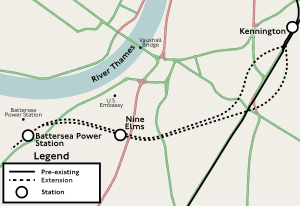| Northern line extension to Battersea | |
|---|---|
 Route of extension | |
| Overview | |
| Status | Opened |
| Locale | London Borough of Wandsworth London Borough of Lambeth London Borough of Southwark |
| Termini | |
| Stations | 2 |
| Service | |
| Type | Rapid transit |
| System | London Underground |
| Operator(s) | Transport for London |
| History | |
| Opened | 20 September 2021 |
| Technical | |
| Line length | 2 mi (3.22 km)[1] |
| Track gauge | 1,435 mm (4 ft 8+1⁄2 in) |
| Operating speed | 45 mph (72 km/h) |
The Northern line extension to Battersea is an extension of the London Underground from Kennington to Battersea in South West London, terminating at the redeveloped Battersea Power Station. The extension formed a continuation of the Northern line's Charing Cross branch and was built beginning in 2015; it opened in 2021.
Two new underground stations were built: Nine Elms and terminus Battersea Power Station. Both stations are in Travelcard Zone 1. Provision was made for a future extension to Clapham Junction. Since the closure of the Battersea Power Station in the 1980s, multiple attempts were made to redevelop the area. In the mid 2000s, Irish property developers proposed extending the Northern line to serve the power station site, to improve connectivity and spur development. After the financial crisis and the collapse of the Irish property bubble in the late 2000s, the Battersea Power Station site was bought by Malaysian investors, who subsequently contributed around £260m towards the construction of the Underground extension.
Construction took six years and cost £1.1 billion (under budget by £160 million) and the extension opened on 20 September 2021. It was the first major extension of the Underground since the Jubilee Line Extension in 1999. It was funded by the private sector, including the developers of Battersea Power Station, with contributions from other developments across the Vauxhall, Nine Elms and Battersea area. The construction of the extension was supported by local councils, property developers and local residents. However, the subsequent development in the Vauxhall, Nine Elms and Battersea areas has been criticised for gentrification and low levels of affordable housing.
- ^ Sheppard, Owen (3 November 2016). "Northern line extension from Kennington to Battersea 'halfway there'". Southwark News. Archived from the original on 7 November 2016. Retrieved 12 January 2016.
